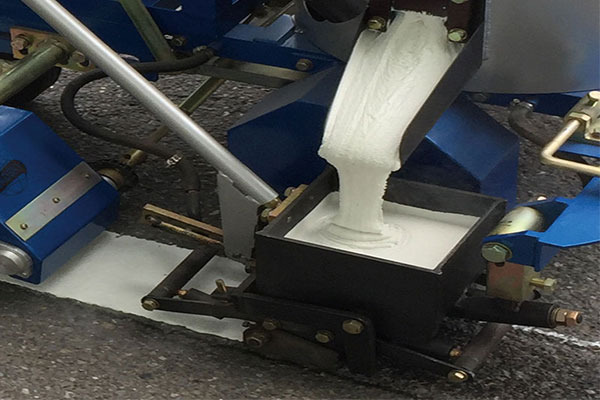Why Choose Thermoplastic Paint for Your Pavement Markings?
Thermoplastic paint is a type of coating that is widely used in various applications, including road markings, airport runways, car parks, playgrounds, and sports fields. It is a versatile material that offers several benefits over traditional solvent-based paints, including durability, resistance to weathering and chemicals, and ease of application.
What is Thermoplastic Paint?
Thermoplastic paint is a type of coating that contains plastic particles that melt when heated, forming a liquid material that can be applied to a surface. The paint is typically applied using a machine that heats the material and extrudes it through a nozzle onto the surface, where it quickly solidifies and forms a strong, durable bond.

Advantages of Thermoplastic Paint
1. Durability
Thermoplastic paint is known for its excellent durability and resistance to wear and tear. This is due to its unique formulation, which includes plastic particles that melt and fuse together to form a solid and robust surface. The resulting coating is much more resilient than traditional solvent-based paints, making it an excellent choice for high-traffic areas and other applications that require long-lasting markings.
2. Resistance to Weathering and Chemicals
Thermoplastic paint is highly resistant to weathering and chemicals, making it an ideal choice for outdoor applications. Unlike traditional paints that can fade and crack over time, thermoplastic paint can maintain its color and integrity for many years, even in harsh conditions. This makes it an excellent choice for road markings, airport runways, and other applications that require long-lasting and reliable markings.
3. Easy of Application
Another advantage of thermoplastic paint is its easy of application. Unlike traditional paints that require multiple coats and long drying times, thermoplastic paint can be applied quickly and efficiently using a machine. This makes it an excellent choice for large-scale projects, such as road markings and car parks, where time and efficiency are crucial.
4. Environmentally Friendly
Thermoplastic paint is an environmentally friendly alternative to traditional solvent-based paints. It contains fewer harmful chemicals and produces less waste, making it a more sustainable and eco-friendly option. Additionally, thermoplastic paint can be recycled and reused, further reducing its environmental impact.
Applications of Thermoplastic Paint
Thermoplastic paint is widely used in various applications, including:
- Road Markings: One of the most common applications of thermoplastic paint is road markings. These markings are critical for ensuring road safety and traffic flow and require a durable and reliable solution. Thermoplastic paint is an excellent choice for road markings as it is highly visible, long-lasting, and resistant to wear and tear.
- Airport Runways: Airport runways require highly visible and durable markings to ensure the safe takeoff and landing of planes. Thermoplastic paint is an ideal choice for airport runways as it is resistant to weathering, chemicals, and heavy traffic, making it a reliable and long-lasting solution.
- Car Parks: Car parks require durable and reliable markings that can withstand heavy traffic and weather conditions. Thermoplastic paint is an excellent choice for car parks as it is highly visible, long-lasting, and easy to apply, making it an efficient and cost-effective solution.
- Playgrounds and Sports Fields: Thermoplastic paint is also can used in playgrounds and sports fields to create vibrant and durable markings for games and activities. The paint’s resistance to wear and tear and its ability to maintain its color and integrity in harsh weather conditions make it an ideal choice for these applications.
- Factory and Warehouse Floors: Thermoplastic paint is also used in factory and warehouse floors to create demarcation lines for safety and organization. The paint’s durability and resistance to chemicals and heavy machinery make it an ideal choice for these applications.
How to Apply Thermoplastic Paint
Thermoplastic paint is typically applied using a specialized machine (Thermoplastic Road Marking Machine) that heats the material and extrudes it onto the surface in the desired pattern. The machine typically includes a tank that holds the paint, a heater to melt the material, and a nozzle to extrude the paint onto the surface.
The process of applying thermoplastic paint typically involves the following steps:
- Surface Preparation: The surface must be cleaned and prepared before applying thermoplastic paint. This involves removing any debris, dirt, or oil that may interfere with the adhesion of the paint.
- Heating the Paint: The thermoplastic paint is heated to a specific temperature using the machine’s heater. The temperature typically ranges between 180 and 200 degrees Celsius.
- Extruding the Paint: The paint is extruded through the nozzle of the machine onto the surface in the desired pattern. The paint quickly solidifies and forms a strong bond with the surface.
- Cooling and Setting: The paint is allowed to cool and set for a few minutes before traffic can be allowed on the surface.
Conclusion
Thermoplastic paint is a versatile and durable paint. With several advantages over traditional solvent-based paint, thermoplastic paint is a great choice if you are looking for a sustainable pavement marking coating.

